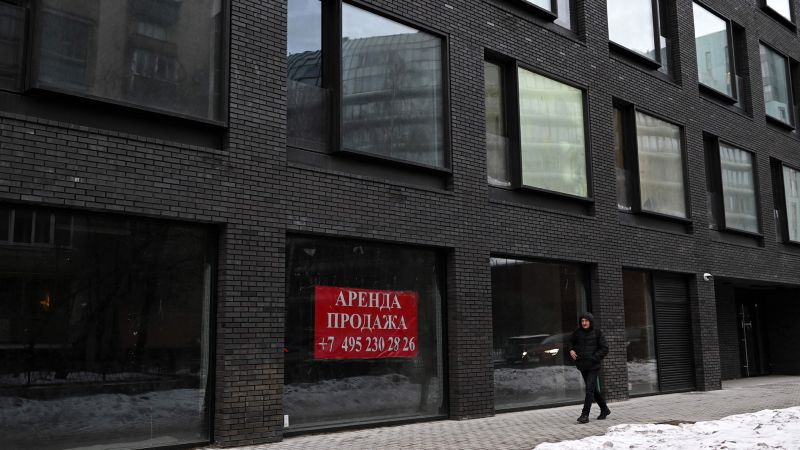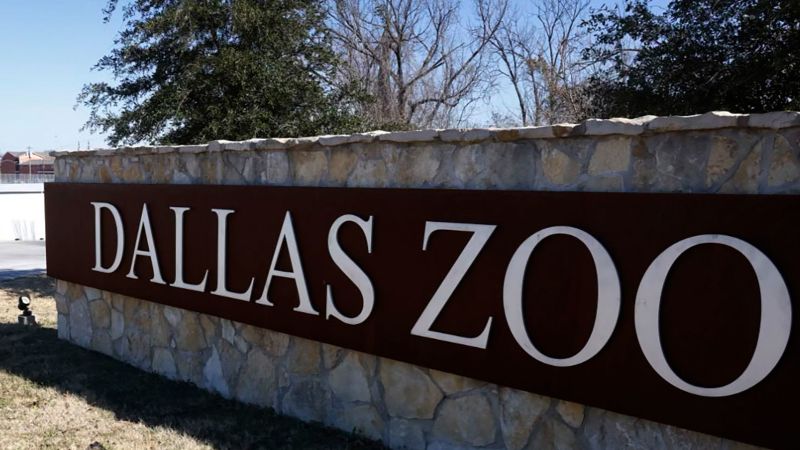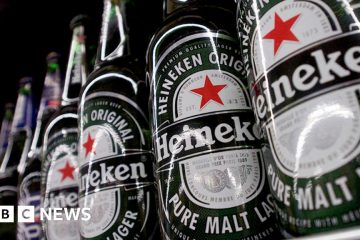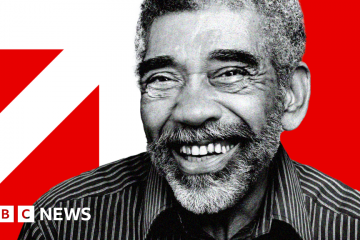London
CNN
—
When Russia launched its full-scale invasion of Ukraine one year ago, Western countries hit back with unprecedented sanctions to punish Moscow and pile pressure on President Vladimir Putin. The aim: to deal an economic blow so severe that Putin would reconsider his brutal war.
Russia’s economy did weaken as a result. But it also showed surprising resilience. As demand for Russian oil fell in Europe, Moscow redirected its barrels to Asia. The country’s central bank staved off a currency crisis with aggressive capital controls and interest rate hikes. Military expenditure supported the industrial sector, while the scramble to replace Western equipment and technology lifted investment.
“The Russian economy and system of government have turned out to be much stronger than the West believed,” Putin said in a speech to Russia’s parliament Tuesday.
Yet cracks are starting to show and they will widen over the next 12 months. The European Union — which spent more than $100 billion on Russian fossil fuels in 2021 — has made huge strides in phasing out purchases. The bloc, which dramatically reduced its dependence on Russian natural gas last year, officially banned most imports of Russian crude oil by sea in December. It enacted a similar block on refined oil products this month.
Those measures are already straining Russia’s finances as it struggles to find replacement customers. The government reported a budget deficit of about 1,761 billion rubles ($23.5 billion) for January. Expenditure jumped 59% year-over-year, while revenue plunged 35%. Deputy Prime Minister Alexander Novak announced that Russia would cut oil production by about 5% starting in March.
“The era of windfall profits from the oil and gas market for Russia is over,” Janis Kluge, an expert on Russia’s economy at the German Institute for International and Security Affairs, told CNN.
Meanwhile, the ruble has slumped to its weakest level against the US dollar since last April. The currency’s weakness has contributed to high inflation. And most businesses say they can’t conceive of growing right now given high levels of economic uncertainty, according to a recent survey by a Russian think tank.
These dynamics place the country’s economy on a trajectory of decline. And they will force Putin to choose between ramping up military spending and investing in social goods like housing and education — a decision that could have consequences both for the war and the Russian public’s support of it.
“This year could really be the key test,” said Timothy Ash, an associate fellow in the Russia and Eurasia program at Chatham House, a think tank.
In a bid to bring Russia to heel for its aggression, Western countries have used their sway over the global financial system, unveiling more than 11,300 sanctions since the invasion and freezing some $300 billion of the country’s foreign reserves. At the same time, more than 1,000 companies, ranging from BP
(BP) to McDonald’s
(MCD) and Starbucks
(SBUX), have exited or curtailed operations in the country, citing opposition to the war and new logistical challenges.
Russia’s economic output duly contracted by 2.1% last year, according to a preliminary estimate from the government. But the hit was more limited than forecasters initially expected. When sanctions were first imposed, some economists predicted a contraction of 10% or 15%.
One reason for Russia’s unexpected pluck was its push toward self-sufficiency following Putin’s annexation of Crimea from Ukraine in 2014. Through a policy known as “Fortress Russia,” the government boosted domestic food production and policymakers forced banks to build up their reserves. That created a degree of “durability,” said Ash at Chatham House.
The swift intervention of Russia’s central bank, which jacked up interest rates to 20% after the invasion and implemented currency controls to buttress the ruble, was also a stabilizing force. So was the need for factories to increase production of military goods and replace items that had been imported from the West.
But the greatest support came from high energy prices and the world’s continued thirst for oil and other commodities.
Russia, the world’s second-largest exporter of crude, was able to send barrels that would have gone to Europe to countries like China and India. The European Union, which imported an average of 3.3 million barrels of Russian crude and oil products per day in 2021, was also still buying 2.3 million barrels per day as of November, according to the International Energy Agency (IEA).
“It’s a question of natural resources,” Sergey Aleksashenko, Russia’s former deputy minister of finance, said at an event last month hosted by the Center for Strategic and International Studies, a think tank. That meant the economy experienced a decline, but “not a collapse,” he added.
In fact, Russia’s average monthly oil export revenues rose by 24% last year to $18.1 billion, according to the IEA. Yet a repeat performance is unlikely, presaging increasingly tough decisions for Putin.
The price of a barrel of Urals crude, Russia’s main blend, fell to an average of $49.50 in January after Europe’s oil embargo — as well as a Group of Seven price cap — took effect. By comparison, the global benchmark stood around $82. That suggests that customers like India and China, seeing a smaller pool of interested buyers, are negotiating greater discounts. Russia’s 2023 budget is based on a Urals price of more than $70 per barrel.
Finding new buyers for processed oil products, which are also subject to new embargoes and price caps, won’t be easy either. China and India have their own network of refineries and prefer to buy crude, noted Ben McWilliams, an energy consultant at Bruegel.
Meanwhile, gas exports to Europe have plunged since Russia shut its Nord Stream 1 pipeline.
Russia’s government relied on the oil and gas sector for 45% of its budget in 2021. As it plans to maximize defense spending, lower revenues inevitably mean trade-offs. Spending plans for 2023 finalized in December involved a decrease in expenditure on housing and health care, as well as a category that includes public infrastructure.
“Whatever energy resources are obtained, they’ll be spent on military needs,” said Gulnaz Sharafutdinova, acting director of the Russia Institute at King’s College London.
The International Monetary Fund still expects Russia’s economy to expand by 0.3% this year and 2.1% the next. Yet any outlook is contingent on what happens in Ukraine.
“Whether the economy shrinks or expands in 2023 will be determined by developments in the war,” Tatiana Orlova, an economist at Oxford Economics, wrote in a note to clients on Tuesday. Shortages of workers tied to military conscription and emigration pose a key risk, she noted.
The impact of Western sanctions is poised to develop into a crisis over time. Bloomberg Economics estimates that Putin’s war in Ukraine will slash $190 billion off Russia’s gross domestic product by 2026 compared with the country’s prewar path.
Sectors that rely on imports have been particularly vulnerable. Domestic car makers such as Avtovaz, which manufactures the iconic Ladas, have struggled with shortages of key components and materials.
Russia’s auto industry was already weakened after companies such as Volkswagen
(VLKAF), Renault
(RNLSY), Ford
(F) and Nissan
(NSANF) halted production and began to sell their local assets last year. Chinese firms have stepped up their presence, part of a broader trend. Even so, sales of new cars dropped 63% year-over-year in January, according to the Association of European Businesses.
Across sectors, firms are struggling to plan for the future. A survey of more than 1,000 Russian businesses by the Stolypin Institute of Economic Growth in November found that almost half plan to maintain production over the next one to two years and aren’t thinking about growth. The group said this contributed to a high risk of “long-term stagnation of the Russian economy.”
Given Putin’s ideological commitment to subsuming Ukraine, he’s unlikely to back down, according to Sharafutdinova at King’s College London. But his war chest “is likely, inevitably, to diminish,” she added.
Prioritizing military spending will also come at a social cost, with a “slow and creeping” erosion of living standards, she added.
“In normal times, we might have said that the population would protest against that,” Sharafutdinova said. “But of course, these are not normal times.”
— Clare Sebastian and Olesya Dmitracova contributed reporting.
Note:- (Not all news on the site expresses the point of view of the site, but we transmit this news automatically and translate it through programmatic technology on the site and not from a human editor. The content is auto-generated from a syndicated feed.))



